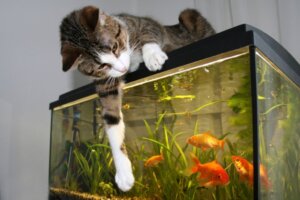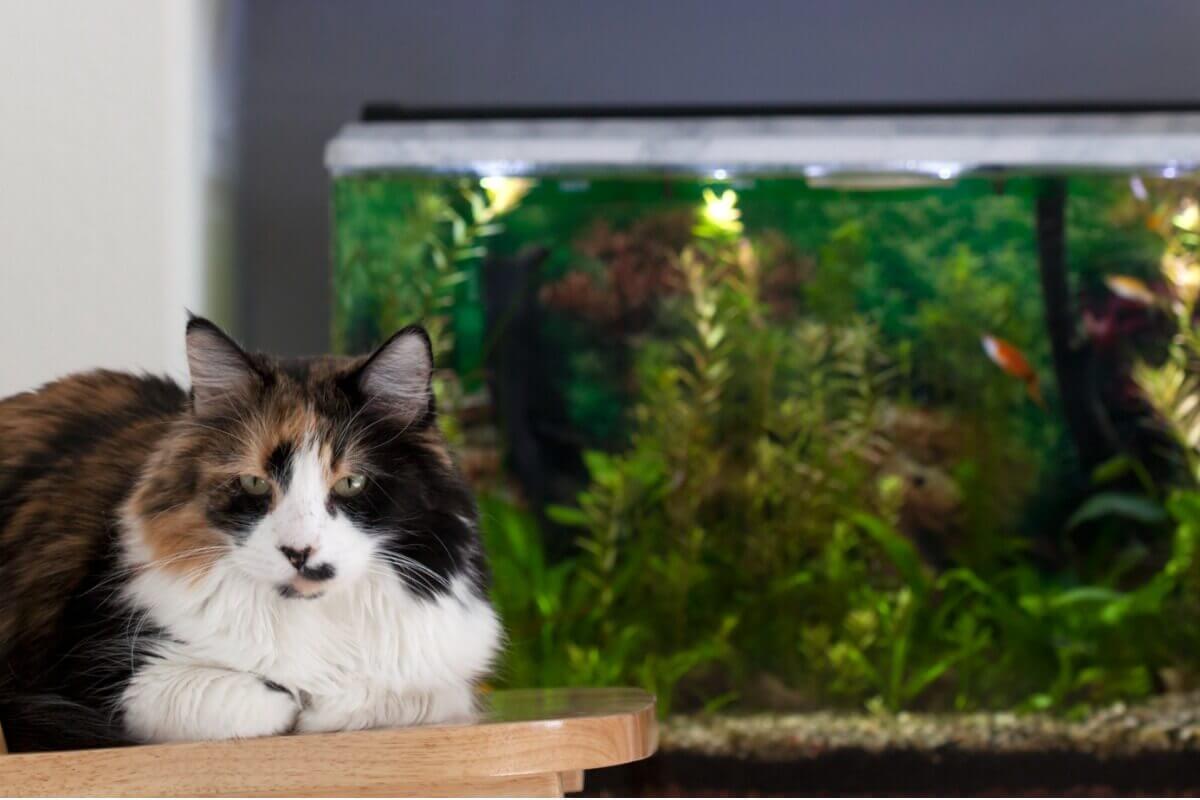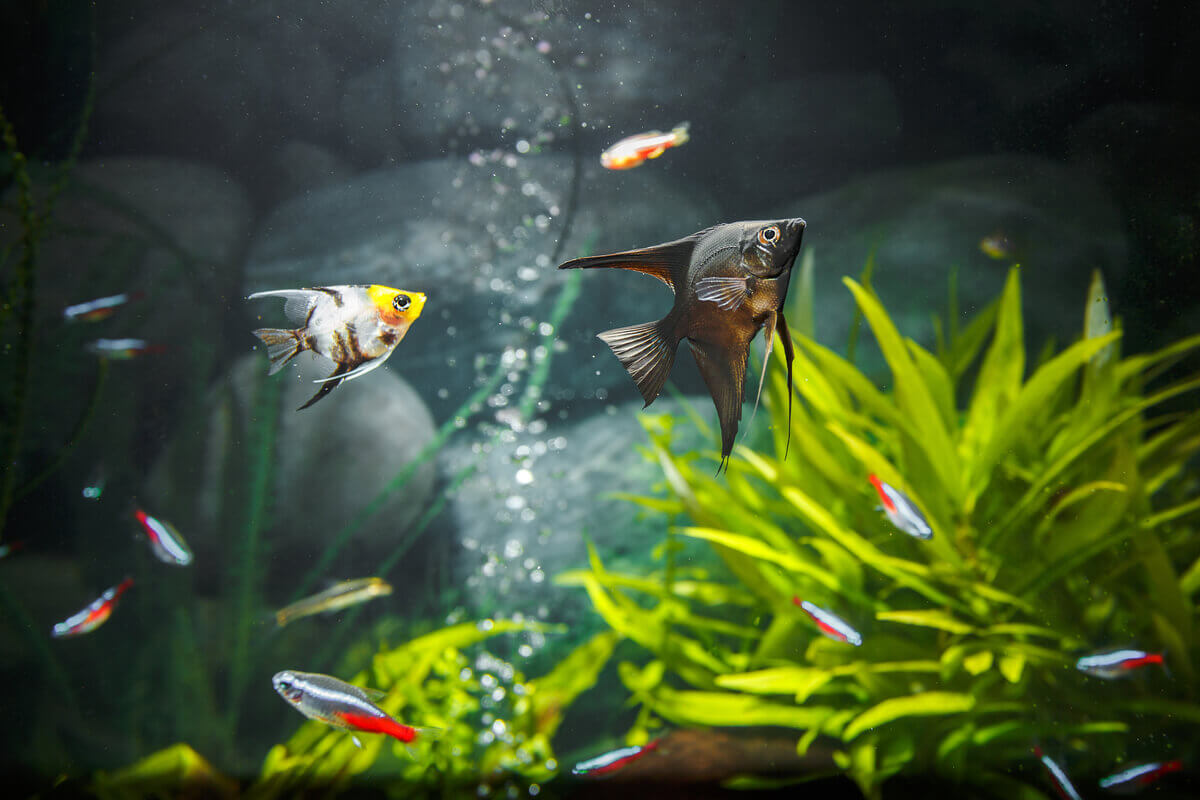Can Cats and Fish Live Together?


Written and verified by the biologist Samuel Sanchez
Do you have a feline at home, but want to increase the number of pets under your care? Unless we’re talking about dogs, things get complicated on this front. Cats are instinctive and predatory animals by nature, so at first, they’ll see any small vertebrate (bird, rabbit, reptile, amphibian, and more) as potential prey. With this in mind, we want to take a look at the following question: Can cats and fish live together?
The answer to this question is complex, as reducing the instinctive load of a feline is a titanic task that can end very badly for all parties involved. Read on if you want to enjoy the company of your feline and an aquarium at the same time. Achieving balance is possible, but it takes effort and dedication.
Feline instinct
We all know that cats are innate predators: You only need to let them loose in the garden for a while and in less than a few hours they’ll have hunted everything that moves. A professional study published in the journal Nature (2013) shows that, in the United States alone, domestic cats kill between 6.2 and 22 billion small mammals every year.
The figure for birds is equally alarming, as in 12 months between 1.3 and 4 billion birds (endemic or introduced) fall in the United States due to the action of domestic or feral cats. This is a serious problem when it comes to the ecosystem and highlights the fact that the hunting instinct of cats has never left their genome.
With these data in mind, it’s not difficult to recognize that any small vertebrate (mouse, squirrel, lizard, bird, fish, and more) will be a potential victim in the eyes of a domestic cat. Therefore, having cats and fish live together in the long term is quite complicated.

Can cats and fish live together?
The simple answer to this question is yes, but it requires extensive nuance. Cats can coexist with domestic fish housed in a large aquarium, but this doesn’t mean that they’ll stop seeing them as prey at any time.
In other words, the feline will probably want to eat the members of the tank even if you tell it otherwise, so the secret is to avoid it. Here are some keys to ensure that interspecific coexistence comes to fruition.
Choose the right model of tank
Fishbowls are the least suitable in these cases, as they have a top opening that will make it much easier for the feline to get its paws into the water. In addition, these structures are lacking in every way: They don’t have enough volume to house any species and the filtering system is null.
It’s best to have a large fishbowl with a heavy and resistant lid that protects the members of the aquarium. It’ll be much better if it has a top snap or is magnetized so that it’ll be impossible for the feline to open it.
Locate it in a safe place
It’s best to place the tank in a high place (ideally a table), but that won’t prevent the feline from accessing it. Keep in mind that domestic cats are capable of jumping up to 6 times their own height and can use their claws to latch onto almost any surface. The tank needs to be high but also isolated from furniture and chairs within 1-2 yards of it.
However, your cat will jump into the tank environment if it wants to. Therefore, we recommend that you fix the base of the aquarium with silicone to the table to avoid serious accidents. In addition, the more volume of water there is in the tank, the less likely it will be for the cat to end up throwing it on the floor.
Place cat repellers in the environment
Cats hate the smells of mint, eucalyptus, and citrus, among many others. Therefore, it’s always a good idea to place a small jar of concentrate of any of these substances in the cabinet of the fish tank. Remember never to pour these contents directly into the tank water, as you’ll poison the fish.
Aluminum edging on the aquarium cabinet can also help, as felines hate the texture of this material.
Cover the aquarium at night
Cats are eminently nocturnal, while most species of fish present in the aquarium environment carry out their activities during the day. Therefore, it’s always best for every tank to have a fixed photoperiod of 8 hours of light per day (something that’s achieved with a spotlight placed on the lid of the aquarium).
As fish don’t need light at night, you can cover the entire aquarium with a blanket or cloth. This will prevent the newly awakened cat ready to hunt from seeing the interesting contents of the tank. In addition, this will reduce the stress of the fish themselves (because they won’t see the cat swarming around).
Place objects on the lid of the aquarium
Ultimately, it may be useful to place heavy objects on the lid of the aquarium. Not only will this prevent your cat from opening the lid, but it will disrupt the feline’s three-dimensional perception a bit before it decides to jump on the tank. In other words, he may lose interest in the tank when he perceives that there is no room for it in the environment.
Keep in mind that the objects you place as a stopper are susceptible to being tipped over. Don’t use anything of value or that could hurt your cat.

A possible coexistence, but difficult
Cats and fish can live together in the domestic environment, but you have to be very careful if you want to avoid imminent disaster. Cats see in every small vertebrate a potential food source and, unfortunately, it’s impossible to remove this instinct. Therefore, the key is to prevent it from accessing the tank, not to allow it to interact with the fish safely.
If all the tricks we’ve given you fail, isolate the aquarium in a safe room and don’t allow the cat to enter it under any circumstances. Remember that the stress of the situation can kill your fish, so don’t let the feline’s conflicting behaviors continue over time.
All cited sources were thoroughly reviewed by our team to ensure their quality, reliability, currency, and validity. The bibliography of this article was considered reliable and of academic or scientific accuracy.
- Loss, S. R., Will, T., & Marra, P. P. (2013). The impact of free-ranging domestic cats on wildlife of the United States. Nature communications, 4(1), 1-8.
- Cat-Proofing Your Fish Tank: How to Protect Your Fish from a Curious Kitty, HS Hills. Recogido a 7 de octubre en https://www.hillspet.com/cat-care/resources/cat-proofing-your-fish-tank
This text is provided for informational purposes only and does not replace consultation with a professional. If in doubt, consult your specialist.